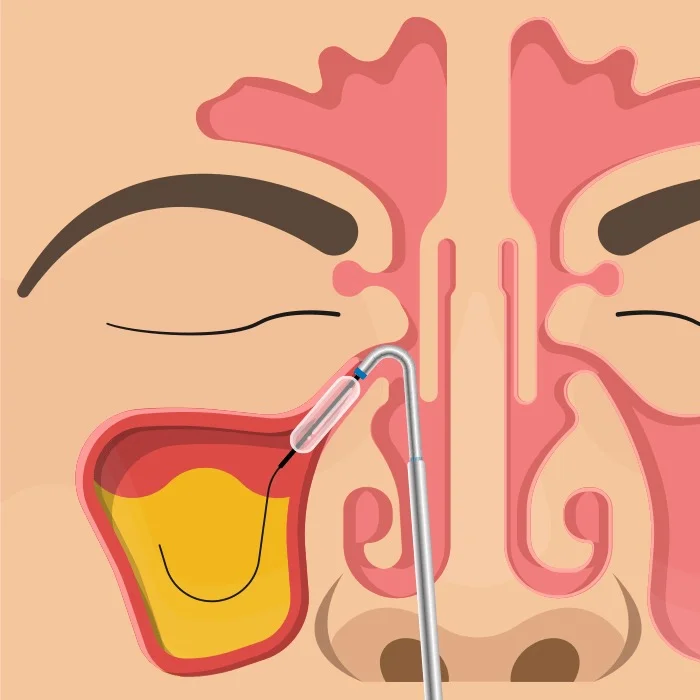
Balloon sinuplasty is a minimally invasive surgical procedure used to treat chronic sinusitis, a condition where the lining of the sinuses becomes inflamed and swollen, causing difficulty breathing through the nose, facial pain, and pressure. For effective relief, consulting the Best Balloon Sinuplasty Doctor & Surgery in Kukatpally ensures advanced treatment and long-lasting results.
how it is performed
Balloon sinoplasty can be performed under local anesthesia or general anesthesia. Balloon Sinuplasty (BSP) uses a small, flexible, balloon catheter to open up blocked sinus passageways and facilitate drainage of the mucus that accumulates in patients suffering from chronic sinusitis symptoms.When the sinus balloon is inflated, it restructures and widens the walls of the sinus passageway while maintaining the integrity of the sinus lining.
Balloon sinuplasty is less invasive than traditional sinus surgery and can often be performed in an outpatient setting. It is generally considered a safe and effective treatment option for chronic sinusitis, with a low risk of complications.
Some of the potential benefits of balloon sinuplasty include:
- Minimally invasive: Balloon sinuplasty is a minimally invasive procedure that can be performed with local anesthesia, making it a less traumatic option compared to traditional sinus surgery.
- Quick recovery: Recovery time is relatively short, with most patients able to return to normal activities within a few days.
- Reduced pain: Balloon sinuplasty is generally associated with less pain and discomfort compared to traditional sinus surgery.
- Improved breathing: Balloon sinuplasty can improve breathing by opening up the sinus passages and allowing for better drainage.
- Fewer complications: The risk of complications associated with balloon sinuplasty is generally low compared to traditional sinus surgery.
Why is the surgery done
Chronic sinusitis can cause a range of symptoms, including facial pain, pressure, congestion, and difficulty breathing through the nose. Balloon sinuplasty may be recommended when other treatments for chronic sinusitis, such as medications, nasal sprays, or allergy shots, have not provided sufficient relief. Balloon sinuplasty may also be used to treat other sinus conditions, such as:
- Recurrent sinus infections: If you experience frequent sinus infections, balloon sinuplasty may be used to open up the sinus passages and prevent infections from recurring.
- Nasal polyps: Balloon sinuplasty may be used to remove or shrink nasal polyps, which are small growths that can develop in the nasal passages and cause obstruction.
- Deviated septum: If you have a deviated septum, balloon sinuplasty may be used in conjunction with septoplasty to improve breathing and reduce the risk of recurrent sinus infections.
What to expect post surgery
After balloon sinuplasty surgery, it is common to experience some discomfort and congestion for a few days. Here are some things you can expect in the days and weeks following balloon sinuplasty surgery:
- Congestion and drainage: You may experience some nasal congestion and drainage for a few days after the procedure.
- Pain and discomfort: You may experience some pain and discomfort in the days following the procedure.
- Activity restrictions: Your doctor may recommend that you avoid certain activities, such as blowing your nose, strenuous exercise, or swimming, for a few days after the procedure.
- Follow-up appointments
- Improvement in symptoms: Many people experience an improvement in their symptoms, such as reduced congestion and better breathing, within a few days of the procedure. However, it may take several weeks to fully recover and see the full benefits of the procedure.
Risks associated with the surgery
Like any surgical procedure, rhinoplasty does come with some risks and potential complications. Some of the risks and potential complications of rhinoplasty include:
- Allergic reaction to anesthesia
- Infection
- Bleeding
- Scarring
Frequently Asked Questions
-
WHAT DOES balloon Sinuplasty
>DO USING A SMALL BALLOON , PLACED THROUGH NOSE IT DILATED SINUS OPENINGS . USED TO TREAT CHRONIC / RECURRENT SINUSITIS / SINUS INFECTION WHEN MEDICAL MANAGEMENT FAILS
-
WHO IS ELIGIBLE FOR Balloon Sinuplasty
when medical management fails we can plan for balloon sinuplasty to increase opening of sinus
-
HOW LONG DOES BALLOON SINUPLASTY LAST
it is a permanent procedure but patients with sinonasal polyps/fungal sinusitis may require revision surgery.
-
WHAT ARE RISKS OF BALLOON SINUPLASTY
minimal blood stain discharge Temporary loss of smell Temporary nasal blockage All symptoms will resolve within 1 week post surgery
-
IS BALLOON SINUPLASTY AVAILABLE IN INDIA
YES
-
CAN YOU SNEEZE AFTER BALLOON SINUPLASTY
regular douching should be done with saline water to prevent crusting.forceful sneezing and blowing of nose should be avoided for 10-15 days
-
Why choose Amrita ENT for Balloon Sinuplasty?
Amrita ENT offers expert surgeons, advanced technology, and personalized sinus care.
-
What sinus issues can Amrita ENT treat with this?
Chronic sinusitis, nasal congestion, and breathing difficulties are effectively treated.
-
DOES BALLOON SINUPLASTY STRAIGHTEN NOSE
NO,balloon sinuplasty is only to widen the opening of sinus
-
IS BALLOON SINUPLASTY SUCCESSFUL
the success rate is 94-96 percent .
-
CAN BALLOON SINUPLASTY FAIL
Only patients with sinonasal polyps and fungal sinusitis or tumor the sinus opening may get blocked and may need revision procedure in future.
-
HOW DO YOU SLEEP AFTER BALLOON SINUPLASTY
NORMAL POSITION
-
CAN YOU BREATHE BETTER AFTER BALLOON SINUPLASTY
YES balloon sinuplasty+turbinoplasty+septoplasty will help in improving breathing.
-
WHAT ARE PROS AND CONS AFTER BALLOON SINUPLASTY
PROS-facial heaviness will reduce and quality of life will improve.
-
Does Balloon Sinuplasty provide long-term relief?
Yes, many patients experience lasting relief from sinus symptoms.
